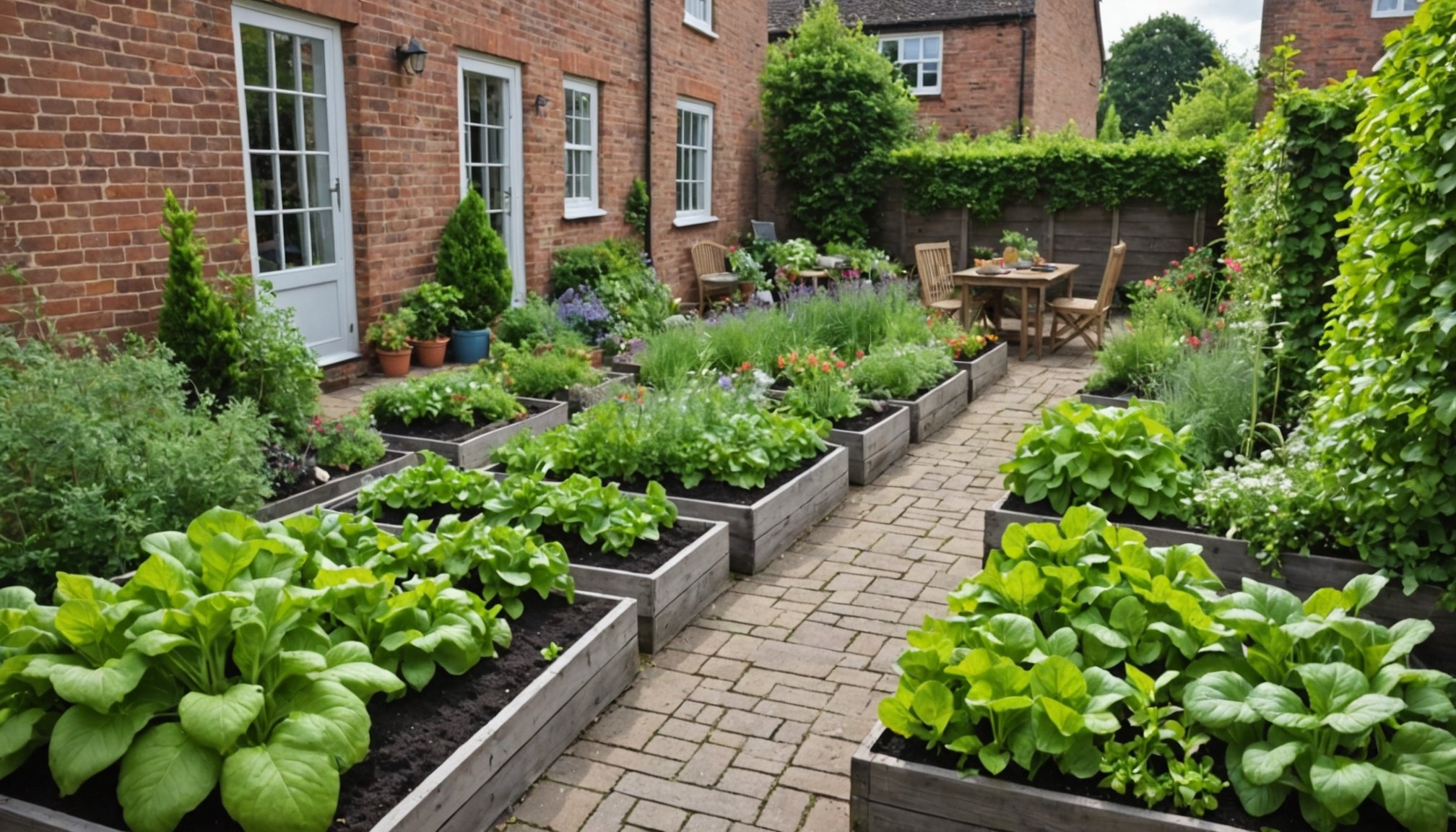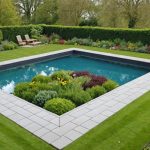Compact courtyards in the UK can become vibrant vegetable gardens with smart planning and creativity. Imagine fresh tomatoes and herbs just steps from your door, enhancing both your meals and your outdoor space. With ingenious vertical gardening techniques, raised beds, and container solutions, transforming your courtyard is more achievable than you think. Discover innovative ways to cultivate your green thumb while maximizing limited space, all while contributing to a sustainable lifestyle. Your journey to a fruitful garden starts right here.
Innovative Gardening Ideas for Compact Spaces
In today's urban environments, finding creative gardening solutions for limited spaces is essential. One effective approach is vertical gardening, which maximizes space by allowing plants to grow upwards rather than outwards. This method not only saves ground space but also adds a unique aesthetic to any area. Vertical gardens can be created using wall-mounted planters, trellises, or even repurposed items like pallets.
Have you seen this : Maximizing Urban Living: Are Vertical Wall Planters the Key to Greening Limited UK City Spaces?
Another space-saving gardening technique is container gardening. This involves growing plants in pots or other containers, making it ideal for balconies, patios, or any small outdoor area. Containers can be easily moved to capture sunlight or to rearrange your space, offering flexibility and convenience. They come in various sizes and materials, allowing gardeners to choose based on their specific needs and style preferences.
Raised bed designs are also excellent for compact spaces, as they provide a controlled environment for plants and can be tailored to fit any area. These beds improve drainage and can be filled with high-quality soil to enhance plant growth. For those with limited ground space, raised beds can be built on legs or stacked to create a tiered effect, further optimizing space usage.
Also read : Ultimate Guide to the Best Mulching Techniques for Weed Control in UK Flower Beds
Choosing the Right Vegetables for Your Courtyard
When it comes to courtyard gardening, selecting the most suitable vegetables is crucial for maximizing both space and yield. Opt for compact varieties such as cherry tomatoes, bush beans, and radishes, which thrive in confined areas. These vegetables not only fit well in small spaces but also offer high productivity.
Companion planting is a strategic approach to enhance growth and yield. By pairing compatible plants, you can optimize space and improve plant health. For instance, planting basil alongside tomatoes can enhance flavour and deter pests. Similarly, marigolds can be placed near vegetables like cucumbers to repel harmful insects.
Understanding the seasonality of vegetables is vital. Cool-season vegetables like lettuce and spinach can be planted early in spring or late summer. Meanwhile, warm-season varieties such as peppers and eggplants are best planted after the last frost. This ensures that each plant receives the optimal conditions for growth, leading to a bountiful harvest.
By carefully selecting vegetable varieties and employing companion planting techniques, your courtyard can become a productive and thriving garden. Embrace the constraints of small spaces by choosing the right plants and planting strategies, ensuring a rewarding gardening experience.
Designing Your Vegetable Garden Layout
Creating an efficient garden layout design is essential for making the most of your available space and ensuring easy access to your plants. Thoughtful planning can lead to a more productive and visually pleasing garden.
Planning Pathways and Access
When designing your garden, consider the placement of pathways to facilitate easy movement and maintenance. Ensure paths are wide enough for comfortable access without disturbing your plants. Use materials like gravel or stepping stones to create durable and attractive paths. This not only aids in space optimization but also enhances the overall aesthetic.
Utilizing Corners and Edges
Maximize your garden's potential by making use of corners and edges. These often-overlooked areas can be perfect for planting compact or climbing vegetables. Consider using trellises or vertical supports in these spaces to grow plants upwards, further optimizing your garden layout design.
Incorporating Aesthetics with Functionality
A well-designed garden should be both functional and beautiful. Choose plants with varying colours and textures to create visual interest. Incorporate decorative elements like sculptures or water features to enhance the garden's appeal. By combining aesthetics with practicality, you can create a harmonious and productive garden environment that delights the senses while ensuring efficient use of space.
Step-by-Step Guide to Setting Up Your Garden
Setting up a garden can be a rewarding experience, especially with the right garden setup guide. Begin by preparing the soil, which is crucial for healthy plant growth. Ensure the soil is rich in nutrients; this can be achieved by mixing in organic compost or well-rotted manure. If you're using containers, select ones that suit your plants' needs and ensure they have adequate drainage holes.
Planting Techniques for Optimal Growth
When it comes to planting techniques, consider the spacing and depth of each seed or plant. This ensures they have enough room to grow without competing for resources. For optimal growth, follow the instructions on seed packets or plant labels, which provide specific details on how deep and far apart to plant. Using a grid system or planting in rows can help maintain an organized layout, making it easier to care for your plants.
Watering and Drainage Solutions
Effective watering is essential for garden success. Water your plants early in the morning or late in the afternoon to minimize evaporation. Ensure your watering and drainage solutions are efficient; overwatering can lead to root rot. Consider using a drip irrigation system for consistent moisture levels, especially in container gardens.
Maintenance Tips for a Thriving Vegetable Garden
To ensure your vegetable garden thrives, garden maintenance and attentive vegetable care are essential. Regular watering is crucial; aim to water early in the morning or late afternoon to reduce evaporation. Consistent moisture levels support plant health, especially during dry spells.
Fertilization is another key aspect. Use organic fertilizers to enrich the soil with essential nutrients. This practice encourages robust growth and improves yield quality. Apply fertilizer according to the specific needs of your plants, usually every few weeks during the growing season.
Pest Control Methods
Effective pest control is vital for protecting your vegetables. Opt for natural methods suitable for courtyards, such as introducing beneficial insects like ladybugs or using neem oil sprays. These solutions deter pests without harming the environment or your plants.
Seasonal Maintenance Tasks
Undertake seasonal tasks to maintain garden sustainability. In spring, prepare your soil and plant cool-season crops. During summer, focus on consistent watering and pest management. In autumn, clean up debris and add compost to enrich the soil for the next planting cycle. By adhering to these maintenance practices, your vegetable garden will flourish.
Enhancing Your Garden with Visuals
Incorporating garden aesthetics can transform your space into a visual delight. Adding decorative elements like sculptures, water features, or colourful pots can elevate the garden's appeal. These additions not only enhance beauty but also create focal points that draw the eye and add interest to your garden.
Garden Art and Furniture for Functionality
Integrating garden art and furniture can serve both aesthetic and functional purposes. Consider using benches or seating areas to provide relaxation spots while complementing the garden's style. Functional art pieces, such as decorative trellises, can support climbing plants and add vertical interest. Choose materials that withstand weather conditions, ensuring longevity and minimal maintenance.
Visual Inspiration from Successful Courtyard Vegetable Gardens
Drawing visual inspiration from successful courtyard gardens can guide your design choices. For instance, a well-arranged mix of vegetables and flowers can create a tapestry of colours and textures. Look for gardens that use vertical space creatively, incorporating hanging planters or tiered shelves. These examples highlight how thoughtful design can maximize space and enhance garden aesthetics.
By focusing on visual inspiration and integrating decorative elements, your garden will not only be productive but also a beautiful extension of your home.











